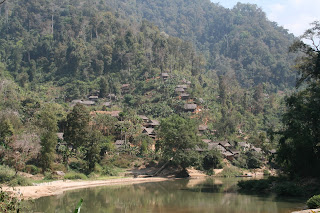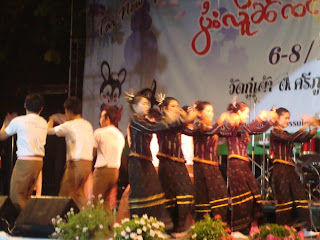 |
| Reusing and redesigning old clothes |
Art activities require little to set up, are easily transportable, and cheap when compared to the learning potential they offer. The space of the activity provides a safe environment for children to blossom according to their personalities. Art as a subject suits nurturing multiculturalism and respecting children various cultural and linguistic backgrounds as they are. Furthermore Studio Xang promotes a non- violent approach with children and encourages non violent conflict resolution amongst children but also with parents.
Mg Thar Nyi from Mae Taung Mai Class gets up early on the day he needs to go to the class and when he is back, he shares his experience with parents. Parents give time to listen what he says and talk each other so that the relationship between parents and children becomes warmer. His parents mentioned that they feel he can think more logically and has more self-confident by looking at his art works and paintings together with his father and listening the meaning of his art works.
Art education is not part of the school curriculum in Burma. Adults from migrant communities never practiced visual arts at school. Very few parents now working as construction workers attended school. Many are illiterate. Therefore Studio Xang puts great efforts in conducting trainings. More over, learning is highly sensitive to the child psycho-social environment. Studio Xang works closely with parents, during home visits and workshops. During these workshops parents practice some of the term’s art activities. This helps parents relate to their children’s learning and encourage it. Parents’ responses to art activities are very positive. They are also surprised by how difficult the activities feel:
“This [modelling animals in Plasticine] is harder than work [on construction site], now I understand that art is more than just play”
“We paint houses all the time but I never knew how to make colours [colour mixing activity]”
“You [Studio Xang] should come and teach us more often”.
Children’s behaviour and expression by means of the artistic practice often highlights issues concerning schooling, health, living and working conditions which Studio Xang teachers actively address with the child and parents when needed. The project works with partner organisations for issues that require assistance outside our capacity such as legal and health matters. Parents outreach and children’s learning assessments provide us with feedback on children ' progresses and any other relevant issues to children wellbeing.
In Chiang Mai and Maesot, Parents’ workshops on Art and child development bring parents from different sites together to engage in art activities. Children and parents social relationships often lay within the perimeter of their workers camp (rows of corrugated iron shacks). Camps tend to differ in terms of quality of living, particularly depending on the foreman/middleman’s attitude to workers.
The activity provides a space for parents to share experience to build relationships with parents from other camps. As Studio Xang develops relationships with our students’ teachers in local Thai schools in Chiang Mai, we will invite Thai teachers to these workshops.
The next too comments are interesting because both child and parent were interviewed:
Myo Pa Pa’s grand-mother said that the girl helps her with house chores and cooks for her. Her grand-child shows her artwork and noticed that she has progressed a lot. Myo Pa Pa, 14, attends the Saturday afternoon class. She likes cooking activities best because she cooks for her grand-mother. Each new course she is excited to find out the next recipe.
Ye Wunna Aung, 15, attends the Sunday morning class. He liked the vegetable stamps activity because it is possible to make an infinity of design. He learnt that art is more than drawing, and that it can be made using any materials. Ye Wunna Aung’s Father said his son never used to speak to people in the community before. Now he talks more and has started to play with other children. His shows more awareness of his environment and draws in his spare time.
In a child’s experience, teachers are the second most important people after parents. Studio Xang puts great emphasis on the quality of its teaching and the continuous training of teachers and volunteers. Intensive teacher trainings, in beginner and advanced levels, take place yearly. The trainings consist of practice based information sharing on child development through art, teaching methods, child psychology, class management, basic art techniques are organized for participants from the migrant community. These trainings are at the root of our organisation’s development.
To support the capacity building for teachers and parents from the migrant community, the project publishes a newsletter in four languages. The project’s previous publications are the teacher’s handbook Art and Child development and the Applied Drama Handbook in local languages. All the PDF versions, English included will soon be available from our website.
Studio Xang has taught children for several years and many of our students are now teenager. The project “Power Kid” has been designed to address this age group’s needs and interest. It started in 2010 and was very well received by youngsters and their families. “Power kid” includes a 4-month Applied Arts training. Three specific skills (previously silk-screen fabric printing, sewing and jewellery) are taught, along with basic business, market research and design skills. Holding a market stall at community events conclude the training process. Participants plan how to re-invest the benefits and create a saving fund for special activities or funding for school materials. Power kid, in chiang Mai only because of security restriction in Maesot, also includes a 3-day summer camp for 30 youth from different workers camps, that aims at developing teamwork and leadership. Other activities will address adolescent reproductive health and labour rights awareness, as well as art activities and outdoor activities.
 |
| Earings made with handmade paper beads |
|
|
 |
| Necklaces using hand made paper beads |
 |
| Phar Eh's special design |
Phar Eh (intern from Mae La Oon) said
“I like this programme. Now, we know how to make such things as bag, necklace, bracelet, etc. If we don’t know how to make them, we have to go and buy in market. Now, we can make them by ourselves and can give others as present.”
 |
| Sewing |
13-year-old Nathtitar Panya living at Samoeng, Grade 6 said
“I would like to have 4-5 sewing machines in the class. As we didn’t have enough machines, we needed to wait for each other and it is a waste time. If we have enough machines, we can learn more than that. By joining the class, I could learn a lot of hand-made skill. I really thank teachers. I will apply those skills I learn well in the future.”
 |
| Lunch |
 |
| Learning to make a repeated print |
 |
| Funky head elephant print |
 |
| Final touches |
 |
| Adding background colour |
The dream behind Power kid is to have a guild styled printing factory where young people can enter as untrained apprentices and work while accessing raining in all the different skills it takes to run a printing factory, from manual labour, supplies, to design, accounting management and ethical and ecological practices.
 |
| Fun time with hair dries |
 |
| Finished products |
 |
| Learning to sell |
In Chiang Mai, the mobile playroom (Rot Xangvisits non-teaching areas to develop potential teaching areas and provide migrant children with access to children’s books, toys and art material on a monthly basis. Rot Xang visits 4 areas, twice a month each. A Rot Xang area can turn into a weekly art class according to children’s needs and parents’ agreement. Rot Xang then moves on to a new area.
To celebrate children’s achievements annual children’s art exhibitions take place in all implementation areas. These exhibitions provide a bridge between the Thai public and the migrant community.
 |
| Maesot exhibition 2010 |
 |
| Chiang Mai exhibition 2010 |
Why do we do it?
 |
| The Shiny House -"Please help pick up the rubbish, here's the bin" | |
| | | | | | | |
| |
| |
| |
| |
| |
| |
| |
| |
| |
| |
| |
| |
| |
| |
| |
| |
| |
| |
| |
| |
| |
| |
| |
| |
| |
| |
| |
| |
| |
| |
| |
| |
| |
| | | | | | | | | |
|
|
Unofficial estimation of the number of registered and non-registered migrant workers in Thailand is 4 to 5 million. The International Organization for Migration (IOM) reported that 200,000 children are registered in Thailand, but the unofficial estimation reaches up to 500,000. Migrant children grow up under difficult circumstances. Being aliens in Thailand, their parents have little protection against abusive behaviour by contractors – neglecting of minimum wages, long working hours, no days off, use of violence, etc. This has a direct effect on life quality and personal development of their youngsters. Migrant communities often have poor living conditions and lack of basic health care. Uneven and irregular access to education is due particularly outside main cities, to a lack of Thai schools in migrant workers living areas. On the other hand, it is a result of parents having to move to find work and being unable to pay for school materials. Although policies allow migrant children to attend schools, in reality many schools refuse them or refuse to give a certificate after completion making it impossible for students to continue further education.
Entering Thai school also requires children to start at primary 1 level regardless of their age because of language difficulties. As a result, many students leave school by the age of 13 but they might have only completed Grade 1 to 3.
Ma Ei Ei Thwe has four siblings and because her father is not feeling well, she started attending school late. She started school last year and she got a chance to join this art class so that parents are very happy. Her mother mentioned that when she is back from the class, she talk with her sisters about her experiences in the class and shares her snack.
Because of their outsider status within Thai society migrant children often lack confidence and suffer from prejudiced behaviour and discrimination by their Thai environment. While Shan workers tend to be more accepted than other ethnic groups from Burma, discrimination in other parts of Thailand is stronger. Our students are children of construction workers, factory workers and orchard workers. They are Shan, Poe and Squaw Karen, Mon and Burman. Religious beliefs include Buddhist, Christian and Muslim faiths.
State and local response to migrants not only limits children’s access to education, it also limits essential aspects of childhood such as play, exposure to the wonders of the outside world, that feed creative and critical thinking, imagination and emotional safety. Over all, children start to work early to help their families. While actively encouraging parents to send their children to school, we use art to support this learning and nurture a wholesome childhood experience.

With its activities Studio Xang aims to promote awareness of and positive attitude towards the migrant community amongst the Thai public. Our project networks with rights advocacy organisations such as MAP foundation as well as local municipal networks. Studio Xang works with partner’s organisations to advocate for migrant children’s rights and facilitate creative platforms where migrant children can represent themselves. Art education is a complex and powerful platform to reflect and question the construction of identity within different social-political contexts. We hope for migrant children’s creative voices to be part of, and partake in shaping the future.
What have we achieved?
































































